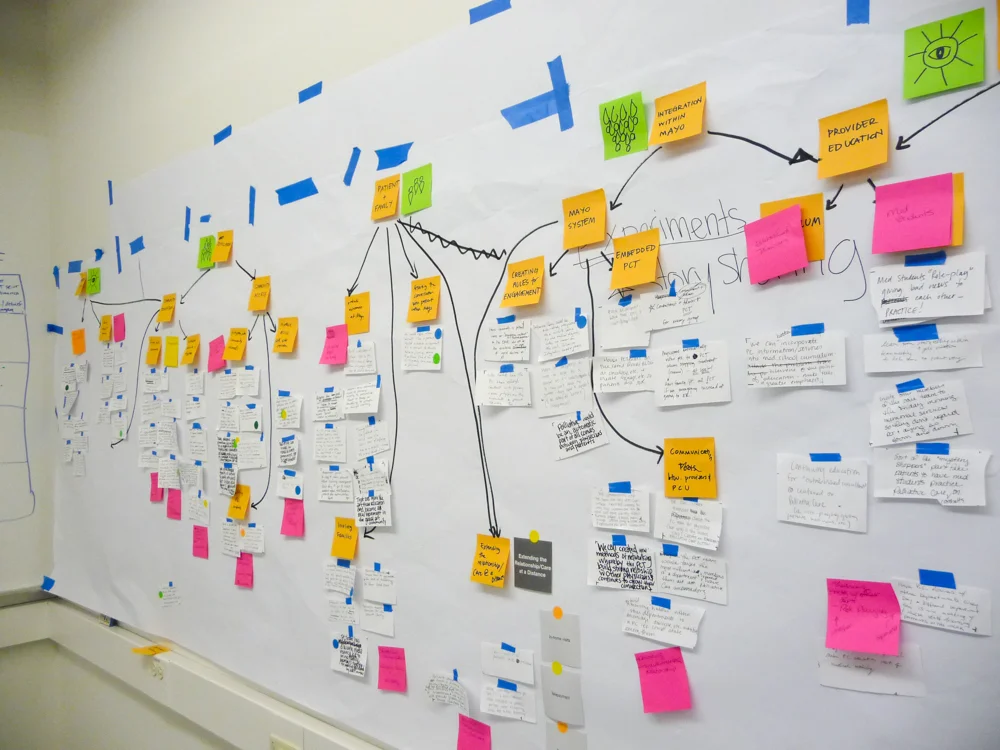Palliative Care
using design research and service design to solve complex problems in healthcare delivery
This project, “Inspiring Innovation in Palliative Care” arose from a collaboration between seven designers at the Mayo Clinic for Innovation for their Future Works skunkworks initiative. When given the chance to engage in a project of our own choosing for one day a week, the group was drawn to palliative care as a provocative and exciting space for innovation.
Palliative care is a specialty within medicine that focuses on establishing goals of care, providing symptom relief and improving the quality of life for patients and families facing life-threatening illness. The team was eager to investigate the space relating to suffering, care options and end-of-life as a way to improve an often overlooked aspect of the healthcare experience.
Role: Design Researcher, Service Designer
Research + Synthesis
Through our research, we sought to answer three key questions:
- How is palliative care currently provided and accessed and what are the influencing factors?
- What is the experience of patients along the course of their illness relating to palliative care?
- How can we facilitate the early integration of palliative care options for outpatients with serious illness receiving care?
We full-filled our study objectives through a mixture of:
Contextual Inquiry
In order to gain understanding of the current perceptions of palliative care within Mayo, the team shadowed and interviewed physicians in the fields of oncology and general internal medicine. One of the most compelling things the design team observed was how the palliative care team was able to help patients make informed decisions about their care by having a dialogue with them and their family about their goals and values. We were able to identify the touch-points where palliative care and hospice care enter the patient conversation.
Secondary Research
Because we were immersed in a research institution, we had access to the wealth of literature published by the Mayo Clinic around the topics of hospice and palliative care. We reviewed these data in order to help inform and inspire our designs.
Stakeholder Interviews
In order to further frame the current system of palliative care delivery, we spoke to palliative care physicians and cardiovascular surgeon in order to understand why patients undergo treatment. We spoke to lawyers and finance managers in order to understand the business barriers to providing palliative care.
Ideation
After synthesizing our research, we identified opportunity areas that would best allow for new opportunities for the integration of palliative care. We then created concepts around three main opportunity areas:
- Culture and Community. Avoiding topics such as terminal illness and end of life in our culture is a barrier to making people aware of palliative care. A change of values needs to start in society and communities, so that people are informed about care options including palliative care and prepared to ask for them.
- Patient and Family. The patient is at the center of healthcare. Therefor, interventions are needed that address and empower patients and equally their families to provide space for conversation about symptom management and quality of life.
- Hospital Systems – Mayo Clinic. For change to be effective, providers and physicians who are delivering health care as well as supporting processes need to be optimized to integrate palliative care.
Deliverables
For our final delivarable, we presented a high-level summary of our research with an intentionally provocative suite of initial service design concepts to the Center For Innovation panel of directors and the Palliative Care Department in order to spark further, formal design projects. Our research and concepts presentation allowed us to begin a relationships with Mayo Clinic's Center for Innovation with their Palliative Care department.
Excerpt from research presentation: "The United States spends over 64% of its healthcare budget on the sickest 10% of the population.viii By focusing on pain management, hospitals, on average, can save $1,700 per patient discharged alive and $5,000 for patients who die in the hospital. Despite these supporting benefits, there remains a need for the expansion of palliative care."
Sample Concept – Advanced Care Directives
This concept arose from the insight that Advance Care Directives are vital for patients to get the care they want. Advanced Care Directives (ACD) identify a patient surrogate to make critical decisions about the patient’s care, as well as provide critical information about care according to patients’ wishes. However, the majority of patients do not have an Advance Care Directive. We believed that integrating ACD in driver's license registration process would broaden awareness of the importance of ACDs since 80% of the American adult population has a driver's license



